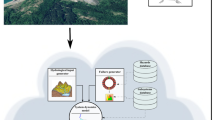Overview
- Editors:
-
-
Lucien Duckstein
-
Department of System & Industrial Engineering, University of Arizona, Tuscon, USA
-
Erich J. Plate
-
Institute for Hydrology and Water Resources, University of Karlsruhe, Karlsruhe, Germany
Access this book
Other ways to access
About this book
Hydraulic, hydrologic and water resources engineers have been concerned for a long time about failure phenomena. One of the major concerns is the definition of a failure event E, of its probability of occurrence PtE), and of the complementary notion of reliability. However, as the stochastic aspects of hydraulics and water resources engineering were developed, words such as "failure," "reliability," and "risk" took on different meanings for different specialists. For example, "risk" is defined in a Bayesian framework as the expected loss resulting from a precisely defined failure event, while according to the practice of stochastic hydraulics it is the probability of occurrence of a failure event. The need to standardize the various concepts and operational definitions generated numerous exciting discussions between the co-editors of this book during 1983-84 when L. Duckstein, under sponsorship of the Alexander von Humboldt Foundation (FRG), was working with E. Plate at the Institute of Hydrology and Water Resources of the University of Karlsruhe. After consulting with the Scientific Affairs Division of NATO, an organizing committee was formed. This comittee - J. Bernier (France), M. Benedini (Italy), S. Sorooshian (U. S. A. ), and co-directors L. Duckstein (U. S. A. ) and E. J. Plate (F. R. G. ) -- brought into being this NATO Advanced Study Institute (ASI). Precisely stated, the purpose of this ASI was to present a tutorial overview of existing work in the broad area of reliability while also pointing out topics for further development.
Similar content being viewed by others
Table of contents (29 chapters)
-
Front Matter
Pages I-VIII
-
Introduction
-
-
- Lucien Duckstein, Erich J. Plate, Marcello Benedini
Pages 1-20
-
Reliability and Risk in Structures
-
-
- Lucien Duckstein, Erich J. Plate
Pages 23-25
-
Design Concepts Based on Risk and Reliability of Structures for Uncorrelated Inputs
-
- E. J. Plate, L. Duckstein
Pages 27-60
-
- Francisco Nunes Correia, Maria Alzira Santos, Rui Raposo Rodrigues
Pages 61-86
-
-
-
-
Risk Based Assessment of Dam Safety
-
-
-
- David A. Moser, Eugene Z. Stakhiv
Pages 175-200
-
-
Reliability and Risk in Water Supply Systems
-
Front Matter
Pages 229-229
-
- Lucien Duckstein, Erich J. Plate
Pages 231-232
-
Water Supply Systems: Uncorrelated Inputs
-
-
-
Water Supply Systems: Correlated Inputs
-
-
Reviews
`The book is an excellent summary of current thought on reliability and risk in water resources. This is an extremely valuable reference source for those starting research in the area particularly the tutorial papers. ...a must for the library of any institution that has individuals doing research in the water resource systems area.'
Water Resources Bulletin, 1987
Editors and Affiliations
-
Department of System & Industrial Engineering, University of Arizona, Tuscon, USA
Lucien Duckstein
-
Institute for Hydrology and Water Resources, University of Karlsruhe, Karlsruhe, Germany
Erich J. Plate




